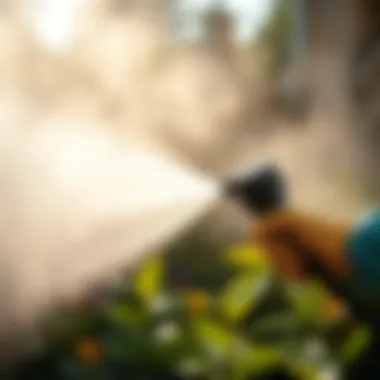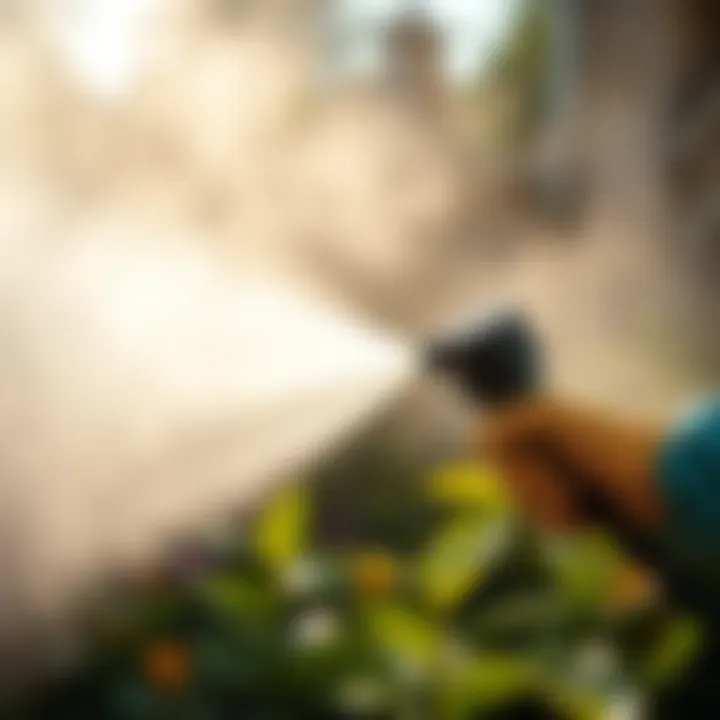Essential Guide to Pest Control Duster Equipment


Intro
Pests have a way of sneaking into our homes, making their presence known when least expected. From tiny ants marching across the kitchen counter to sneaky rodents hiding within the walls, these unwelcome guests can disrupt our daily lives. Therefore, understanding how to effectively manage these nuisances becomes crucial. That's where pest control duster equipment comes into play.
Using dusters to apply pest control materials can be an effective strategy for both homeowners and professionals alike. This guide not only delves into the types and applications of pest control dusters but also discusses their maintenance and efficiency in managing pests. As we navigate through the content, both amateurs and seasoned pest managers will find valuable insights for tackling their unique challenges with these devices.
Let's kick off this exploration by looking deeper into the pests themselves.
Prelims to Pest Control Duster Equipment
When it comes to safeguarding our homes from pesky insects and critters, many homeowners find themselves at a crossroads, trying to decide the best route for pest control. This is where pest control duster equipment enters the scene, acting like the unsung hero in the realm of pest management. Without a doubt, understanding this equipment is crucial for anyone aiming to maintain a pest-free environment.
Pest control dusters serve a specific purpose, allowing for the precise application of insecticidal dusts in areas that often go unnoticed. Utilizing this tool can make a world of difference, particularly when dealing with small cracks, crevices, and hard-to-reach places where pests might be hiding. For instance, a crawlspace that is neglected could be home to a whole family of termites or ants, and a duster can effectively deliver the necessary treatment right where it’s most needed.
The Benefits of Using Dusters
- Efficiency: Dusters allow for an even distribution of dust, meaning that homeowners can effectively cover a large area with minimal effort.
- Control: Unlike spray applications that may drift or miss spots, dusters ensure the targeted application of insecticides where pests are likely to congregate.
- Versatility: They can be used for various types of pests, including ants, bedbugs, and roaches, making them a useful addition to any pest management arsenal.
Yet, like any tool, the effectiveness of duster equipment boils down to understanding how to use it properly. Many homeowners might be tempted to stick with more common methods like sprays or traps, but understanding the subtleties of dusting can bring about superior results—in essence, you might be aiming for the high road in pest control. Thus, knowledge about this equipment not only keeps your living spaces comfortable, but it also empowers homeowners, transforming them into knowledgeable caretakers of their environment.
In this article, we will delve deep into the world of pest control duster equipment, exploring various types available in the market, their specific applications, and maintenance practices. With the right information, you can make informed decisions that align with your pest control goals, catering especially to the needs of individuals managing their household environments. This guide serves to illuminate the lesser-known aspects of pest control, ensuring that you're well-equipped for whatever creepy-crawly may come your way.
Understanding Pest Control Dusting Principles
A solid grasp of pest control dusting principles is paramount for anyone wanting to tackle pest issues effectively. At its core, dusting is about delivering pesticides or other pest-repelling agents to surfaces where pests might roam or nest. Unlike liquid sprays, which can wet and saturate surfaces, dusts form a residue that can linger longer, providing a prolonged effect. This characteristic is particularly crucial for homeowners who seek to maintain a pest-free environment with less frequent applications.
Mechanism of Dust Application
The mechanism behind dust application hinges on both the physical properties of the dust and the techniques used in its application. Dusts, which are fine particles, can adhere to surfaces including walls, floors, and even the fur of crawling insects. This is largely because they have a greater surface area compared to liquids, allowing for increased interaction with pests.
Application Techniques involve several methods, such as:
- Handheld Dusters: Ideal for small areas or precise targeting, these allow users to apply the dust gently and control the amount released.
- Motorized Dusters: For larger spaces, these offer a robust solution, dispersing dust evenly over wider areas. They tend to cover a larger area faster and are particularly useful in agricultural settings.
- Compressed Air Dusters: Often used in more delicate scenarios to avoid damage to the surrounding environment while efficiently distributing the dust.
Every method depends on what you're trying to achieve and where it’s being applied. Understanding these methods fully can save time, money, and effort in the long run.
Benefits of Dusting vs. Other Methods
Dusting holds several advantages over alternative pest control methods, such as sprays or traps. Here are a few notable benefits:
- Residual Effect: Dusts cling to surfaces longer than liquid products, providing extended protection against pests.
- Wind and Rain Resistance: Dusts tend to resist environmental factors better than liquids. A light rain might wash away sprays, while dust is less likely to be affected.
- Targeted Treatment: Dusts can be applied discreetly in hard-to-reach places, such as wall voids or beneath appliances, where insects often hide. This minimizes product exposure and conserves the pest control agent.
It's easy to see why many professionals lean toward dusting as their preferred method. The choice between dusting and other pest control equipment often boils down to efficacy in various scenarios, environmental considerations, and the specific pests involved.
"Dusting is not just about applying a product; it’s about smart application that fits the situation."
In summary, the understanding of dusting principles is vital for effective pest management. It determines how equipment is chosen, applied, and maintained, thereby enhancing the success rate of pest elimination efforts.
Types of Pest Control Duster Equipment
Pest control is a delicate dance between managing nuisance pests and ensuring a safe environment. The effectiveness of your strategy can hinge significantly on the type of duster equipment you opt for. Different dusters serve various purposes, which is what makes understanding the types available crucial. In this section, we delve into the various kinds of pest control dusters, their unique advantages, and the considerations you should keep in mind when choosing one.
Handheld Dusters
Handheld dusters are the trusty sidekicks of pest control, combining simplicity with efficiency. Compact and user-friendly, these dusters are typically designed for small-scale applications. Homeowners often appreciate their maneuverability and ease of use. They work well in hard-to-reach areas—think nooks, crannies, or attic corners—where larger devices might not fit.
- Pros:
- Cons:
- Lightweight and portable—easy to carry around.
- Excellent for targeted treatments, as you can apply dust exactly where needed.
- Cost-effective compared to larger, powered models.
- Might require more physical effort, especially for larger infestations.
- Limited dust capacity can lead to more frequent refilling.
When using a handheld duster, aim for even dust distribution, gently shaking as you go. Remember, less is often more; it’s about providing a thin layer rather than a thick coating.
Motorized Dusters
Now, if you want to crank up your pest control game, motorized dusters are your answer. These machines are designed for greater efficiency and coverage, especially beneficial for medium to large areas. They take the labor out of the equation, allowing for quicker applications and broader reach.
- Pros:
- Cons:
- Increased power means faster job completion—perfect for extensive properties.
- Adjustable settings allow for varied application according to the task.
- Often built with durability in mind, suitable for repeated commercial use.
- Heavier and less portable compared to handheld dusters.
- Typically more expensive, requiring a larger upfront investment.
Using a motorized duster requires some familiarization. It's essential to understand its weight and maneuverability—practice makes perfect in mastering this equipment.
Compressed Air Dusters
Finally, we have compressed air dusters, which transform the way dust can disperse. These dusters rely on compressed air to propel dust towards target areas, making them somewhat unique in their operation. They are particularly effective for indoor pest control, especially in spaces filled with delicate electronics.
- Pros:
- Cons:
- Precise application without making a mess, useful in sensitive areas.
- Versatile; can often be used interchangeably for cleaning as well as pest control.
- Ideal for indoor settings where eliminating pests without residue is crucial.
- May not be effective for large outdoor applications.
- Requires a source of compressed air, which may limit accessibility.
For effective use, avoid over-saturating the area with dust, as the compressed air can lead to excessive dust flow. Remember, a light touch can deliver potent results.


In summary, the type of pest control duster you choose will significantly determine the success of your pest management efforts. Each category has its unique benefits and considerations, so knowing your specific needs—be it indoor use or extensive coverage—will guide you towards making an informed decision.
Choosing the Right Duster for Specific Pests
Selecting the appropriate duster for pest control is not merely a matter of picking the latest model on the market. It's about understanding the unique traits of the pests you're dealing with and tailoring your approach accordingly. A well-chosen duster can increase the effectiveness of your pest management efforts, while an unsuitable one can result in wasted time and resources.
Identifying Target Pests
Understanding the specific pests that are invading your space is the first step in ensuring effective pest management. Each pest has particular characteristics that require different handling and treatment options. For instance, while ants might only need a light dusting to disrupt their trails, larger pests like termites may require a more substantial application to penetrate wood structures.
To help you identify your target pests, consider these tips:
- Examine physical characteristics: Noting the color, size, and shape of the pest can be crucial. For example, bedbugs are typically small and brown, while cockroaches range in size and color.
- Notice the behavior: Are they swarming? Where do they seem to congregate? This information can lead to effective treatment zones.
- Utilize online resources: Websites like National Pesticide Information Retrieval System can provide visual aids and further information on pest identification.
Evaluating the Environment
Before applying any dust, it is essential to assess your environment. Different settings dictate distinct strategies. Typically, indoor settings require greater precision due to obstacles like furniture and electronics, while outdoor environments may necessitate broader coverage where pests roam freely.
- Indoor assessments should focus on areas where pests are typically found, such as kitchens, basements, or attics. Consider the layout and accessibility of these areas.
- Outdoor evaluations need to consider the size of the area, the type of vegetation, and potential areas of shelter or breeding grounds. Are there dense bushes or piles of debris that could harbor pests?
This evaluation not only helps in pest identification but also in determining the right dust formulation. Some dust options are designed for specific conditions, such as wet or dry conditions, which can influence the success of the treatment.
Considerations for Indoor vs. Outdoor Use
The context in which you are using the duster largely influences your choice. Indoor use requires a keen focus on safety and appropriateness of the pest control dust. Most importantly, you want to ensure that your family and pets are safe during the application.
- When using dust indoors, opt for formulations that are hypoallergenic and less harmful. Look for dusts that mention being safe for residential use on the label.
On the other hand, outdoor dusting can often use a wider range of products since exposure risks are different. However, it’s crucial to consider environmental impact, including possible harm to beneficial insects like pollinators.
In essence, whether you’re dealing with indoor pesky critters or outdoor marauders, understanding these distinctions can save you time, effort, and ultimately keep your home safe and pest-free.
"Choosing the right pest control duster is pivotal not only in eradication but in maintaining a healthy living space."
The next step involves applying the correct techniques effectively, leading to a greater possibility of success in your pest management strategy.
Application Techniques and Best Practices
When it comes to pest control, the right application techniques can make all the difference. Understanding how to properly use pest control dusters not only ensures maximum effectiveness but also minimizes health risks to yourself and others around you. You wouldn't want to create a cloud of dust that does little more than send pests scattering temporarily while leaving your space compromised.
Proper Dusting Techniques
To begin with, the method of application matters a lot. Here are some essential techniques to keep in mind when using a pest control duster:
- Distance Matters: Stand at a distance that allows for even distribution of the dust. Generally, a distance of about 12 to 18 inches from the target area is advisable. This keeps unnecessary accumulation in one spot while ensuring proper coverage.
- Slow and Steady: It’s best to move your hand slowly when applying the dust. Rushing can lead to clumps forming instead of even application, allowing some areas to remain vulnerable to pests.
- Direction of Drift: Be mindful of wind direction if applying outdoors. Dust can easily be blown away if not directed properly. Optimizing your position in relation to wind can save you a lot of time and product.
- Target the Right Areas: Focus specifically on areas where pests are likely to hide or travel. Common spots include wall cracks, under appliances, and around windows.
- Limit Usage: Avoid overapplying. More dust doesn't necessarily mean better results. Instead, you can check if pests are returning after application; this can guide how much product is truly needed going forward.
Using these techniques enables one to become more precise in pest control, fostering an efficient routine and effectively managing household pest populations.
Frequency of Application
Now, let’s talk about timing. Just as you wouldn’t water a plant every day for it to thrive, you shouldn't dust your home indiscriminately. Frequency of application holds significant weight in pest control efficacy. Here are some practical insights to consider:
- Initial Application: After identifying a problem area, it's often good to apply a dusting solution. This initial step is crucial to reducing the existing population.
- Follow-Up Applications: Consistency is key. Generally, a follow-up dusting every three to six weeks, depending on the severity of the infestation, can help maintain control. Remember, one shot isn’t always adequate—think of it as a marathon, not a sprint.
- Seasonal Changes: Certain pests, such as ants and cockroaches, are more likely to invade during specific seasons; hence, you might need to adjust application frequency based on the season or environmental changes.
- Post-Application Monitoring: Observe pest activity closely after applications. If pests are still being spotted frequently, it might be time to re-evaluate and apply again sooner. Conversely, if pest activity is low or absent, you might stretch your application interval.
These application techniques and considerations not only promote the effectiveness of the dusting process but also boost your overall confidence in managing pest situations yourselves.
"A well-timed dusting can create a defensive barrier that pests think twice before crossing."
Ultimately, mastering application techniques and understanding the importance of frequency can transform your pest control efforts from hit-or-miss approaches into a well-tuned strategy, allowing for greater peace of mind in maintaining your home.
Maintenance and Care for Duster Equipment
Maintaining duster equipment is not just about extending lifespan; it’s critical for ensuring efficient pest control. Well-kept dusters lead to effective pest management, which protects homes from infestations. Regular maintenance involves cleaning, inspecting, and occasionally tuning up your equipment. Neglect can result in clogs or ineffective dispersion of dust, which could mean pests stick around longer than necessary.
Duster equipment often represents a significant investment, both financially and in terms of time spent understanding how to use it. Keeping them in top condition fosters reliability when you need a quick fix for a pest problem. Moreover, a well-maintained duster contributes to sustainable practices. Dusting improperly made or old equipment might lead to excess waste, not to mention the frustration of using faulty tools.
Cleaning Practices
Keeping your duster clean is paramount. After each use, make it a habit to clear out remaining dust. Residuals can clump inside the equipment, leading to poor performance. Here’s how you can maintain a clean duster:
- Disassemble: Start by disassembling the duster according to the manufacturer's instructions. Check manuals or guides for specific disassembly steps.
- Wash the components: Use warm, soapy water for plastic and metal parts; ensure no soap residue remains, as it can interfere with dust application.
- Dry thoroughly: Moisture can lead to clumping or even rust in metal parts. Allow components to air dry completely before reassembling.
- Check filters: If your duster has filters, clean or replace them based on usage. A clogged filter can drastically reduce the efficiency of the device.
Adopting these cleaning habits prevents major buildup issues, ensuring your dusting efforts go as planned.
Inspecting for Damage
Routine checks for damage can save you from those unexpected moments when your duster fails mid-application. Not all wear and tear is visible, but putting in a little extra effort can highlight potential problems:
- Look for cracks: Over time, materials can develop cracks that might not seem serious at first but can lead to bigger issues. Inspect containers and nozzles closely.
- Check seals and joints: Ensure that seals are intact and joints fit well. Loose parts can affect performance and result in wasted product.
- Examine hoses: If your duster uses hoses, ensure they are free from kinks or punctures. A damaged hose can disrupt the flow of dust.
Giving your duster a thorough inspection regularly ensures safety and performance. Remember, if something seems amiss, consult a professional or the manufacturer for repairs.
Regular maintenance is the cornerstone of effective pest control, enabling equipment to work correctly when it’s needed most.
Keeping pest control dusters in good condition isn’t just about efficiency; it’s about being prepared for pest infestations, no matter when they strike. The time spent ensuring everything remains in working order pays off with every successful application.
Safety Considerations in Dusting Applications
When it comes to pest control, especially through tools like dusters, ensuring safety is paramount. Dusting applications are designed to eradicate pests efficiently. However, they can pose certain hazards if not handled properly. This section delves into specific elements concerning safety, emphasizing the benefits and considerations for both the person applying the pest control and the surrounding environment. Understanding these aspects can significantly reduce risks and maximize effectiveness during pest management.


Protective Gear and Equipment
Using protective gear is non-negotiable in pest control dusting. The dust itself can be quite fine and may irritate skin, eyes, or respiratory tracts. Here’s a checklist of essential protective equipment that should be employed:
- Gloves: Wear durable, chemical-resistant gloves to shield your skin from potential allergens and irritants.
- Mask: A properly fitted dust mask or respirator is vital to guard against inhalation of harmful particles.
- Goggles: Protect your eyes from dust particles that might get flung about during application.
- Long Sleeves and Pants: Clothing that covers skin will add another layer of protection. Ideally, these should be made from materials that won't trap dust.
- Boots: Sturdy footwear will protect feet from spills.
Taking time to don the correct gear before starting dusting will keep you much safer. Should the dust come into contact with skin or eyes, it's essential to have remediation steps at hand, such as rinsing with water or seeking medical attention if necessary.
Minimizing Environmental Impact
Using pest control dust effectively should align with a commitment to protecting the environment. Here are some strategies that not only curb risks to human health but also minimize effects on flora and fauna:
- Targeted Application: Be precise in where and how you apply dust. Limit applications certain areas rather than widespread scattering. This reduces unnecessary exposure to non-target organisms.
- Opt for Eco-Friendly Dusts: Consider natural dust options like diatomaceous earth or neem powder, which are less harmful compared to synthetic chemicals. These solutions can often be just as effective.
- Adhere to Recommended Application Rates: Overusing dust can lead to excessive buildup in the environment. Following guidelines provided by manufacturers ensures responsible usage.
- Observe Weather Conditions: Avoid applying dust on windy days to prevent drift. Apply during calm weather when pest activity is high but human and pet presence is low.
Adopting considerate application methods not only leads to successful pest management but upholds environmental integrity. The goal is to strike a balance between effective pest control and safety, which allows everyone—humans and wildlife alike—to thrive.
Eco-Friendly Alternatives to Chemical Dusts
As homeowners look for effective methods to manage pests, the concern for environmental impact is surfacing more prominently. Chemical dusts, while effective, introduce a host of potential risks not only to humans and pets but also to nearby wildlife and the ecosystem. Opting for eco-friendly alternatives isn't just a trend; it's a commitment to a healthier home and planet.
The benefits of using eco-friendly pest control dusts stretch beyond mere safety. These alternatives often employ natural ingredients that minimize harm while effectively tackling infestations. Here’s what you need to consider when looking for eco-friendly options:
- Safety for All: Natural substances often won't pose health risks to family members, including pets and children, which is a strong selling point.
- Sustainable Practices: Using products derived from plants or minerals promotes sustainability, sustaining the natural balance of ecosystems.
- Community Support: Using these methods aids neighborhood wildlife, which in turn benefits agriculture and local gardens.
- Cost Effectiveness: Many natural options can be made at home, saving money on store-bought solutions in the long run.
"Choosing eco-friendly products is a way of voting with your money; it supports sustainability and safer living.”
Natural Dust Options
Natural dust options present a practical solution for pest control. Common materials include diatomaceous earth, boric acid, and even clay, all offering unique pest-fighting properties without harsh chemicals.
- Diatomaceous Earth: This fine powder is made from fossilized aquatic organisms. When insects come in contact with it, it strips away their protective layer, leading to dehydration.
- Boric Acid: Although it sounds intimidating, this natural compound is actually quite safe for homes. It disrupts the insect's digestion and can effectively target cockroaches, ants, and other unwanted visitors.
- Clay Dusts: Certain types of clay can be used to deter pests effectively by layering it in gardens or around the home.
In use, it’s important to apply these natural dusts in areas where pests are problematic, keeping in mind that efficacy may come with a learning curve when compared to synthetic options.
Homemade Pest Control Dusts
Creating homemade pest control dusts offers a way to tailor solutions to specific pest problems. This not only allows for control over ingredients but also boosts confidence in using environmentally safe measures. Here are some ideas you can easily whip up at home:
- Powdered Spices: Cinnamon and cayenne pepper, for example, can deter ants and other pests without causing harm.
- Baking Soda and Sugar Mix: A potent combination that lures pests while causing harm to their systems when consumed.
- Essential Oil Infusions: Oils like peppermint and tea tree oil can be mixed with a fine dust to add potent repelling properties.
When crafting homemade solutions, it’s vital to keep track of the ratios and application methods for effectiveness. Always ensure that these mixtures are used appropriately, especially around areas where children or pets frequent.
For further guidance on eco-friendly pest control, visit resources like the EPA or join online communities on platforms such as Reddit or Facebook.
Comparing Commercial and DIY Duster Equipment
When it comes to managing pests effectively, choosing the right duster equipment can impact your success rates. Understanding the differences between commercial and DIY options is crucial for homeowners and housewives alike. Not only do these choices influence how efficiently you can apply dust, but they also affect your budget and the overall pest control strategy. Let’s dive deeper into the pros and cons of each.
Pros and Cons of Commercial Dusting Equipment
Commercial duster equipment often comes with a hefty price tag, but there are specific advantages that can justify the investment:
- Reliability and Consistency: Commercial dusters are typically designed for heavy-duty use. They often come with warranties and customer support, which adds to their reliability.
- Superior Technology: Many commercial dusters use advanced spray technologies that ensure even dust distribution, something that might be challenging with DIY solutions.
- Durability: Built to last, commercial dusters can withstand the wear and tear of rigorous use in both residential and commercial settings.
However, these advantages come with some disadvantages:
- Cost: One of the main drawbacks is the initial investment. My word, it can hit your wallet hard!
- Complexity: Some commercial dusters may come with features that could confuse novice users, leading to improper use and subpar results.
- Overkill for Minor Problems: If you're only dealing with a few pesky insects at home, investing in commercial tools might be excessive.
Overall, if you're handling significant infestations or plan on using your duster extensively, the benefits may outweigh the costs. Still, it’s important to evaluate your specific needs.
Benefits of DIY Solutions
On the flip side, DIY pest control dusters offer flexible and customizable options that can be quite appealing:
- Affordability: DIY solutions often come in at a lower cost, making it easier for most homeowners to tackle pest issues without breaking the bank.
- Customization: You can mix and match materials to create a dust that suits the specific pests you're up against. You get to be the boss!
- Simplicity: Many DIY dusters can be made from household items, which means you can set one up in no time at all. Just a little creativity and you’re sorted.
- Eco-friendliness: By using natural ingredients, you can minimize your environmental impact. For those looking for green options, this becomes a significant factor.
However, be wary of the potential downsides:
- Inconsistent Results: Not all DIY solutions will work for every pest. You might find that your homemade formula lacks the punch of a commercially available product.
- Limited Longevity: Sometimes, homemade dusters can break or wear out faster than their commercial counterparts, requiring more frequent replacements.
- Learning Curve: If it's your first time crafting a DIY solution, trial and error might come into play. It may take time to perfect the technique.
Ultimately, it boils down to what best fits your lifestyle and pest management needs. Whether you lean towards commercial products or opt for DIY solutions, understanding the nuances helps you make a choice that's right for your household. Having the right tools can make dealing with pests less of a chore and more of a breeze!
Evaluating Effectiveness of Dusting Equipment
When it comes to pest control, dusters play a pivotal role in effectively managing pest populations. Evaluating the effectiveness of dusting equipment is not just a matter of picking up a clean tool and applying the dust; it involves a thorough understanding of what constitutes effective pest management. The choice of a duster can significantly impact the overall success of pest mitigation strategies, and recognizing this can make all the difference.
Metrics for Success
To measure the effectiveness of your dusting equipment, it is essential to establish metrics that will guide you in assessing how well the duster is performing. Below are some key indicators:
- Application Consistency: Consistency in applying the pest control dust is crucial. If you find that some areas are consistently treated while others are missed, that points to an issue with your equipment or technique.
- Coverage Area: An effective duster should cover the required areas without leaving any blind spots. Keeping track of how much area you cover and how consistently can help assess the efficacy.
- Pest Populations: Keeping tabs on the pest populations before and after treatment can serve as a direct measure of the duster’s effectiveness. You may use traps or simply monitor visually to gauge infestation levels.
- User Experience and Feedback: Sometimes, it’s just about how easy it is to operate the duster. An easy-to-use duster can result in more thorough and effective applications.
- Durability and Maintenance Needs: A tool that necessitates subsequent repairs or has a short lifespan does not provide value over time; thus, its effectiveness is limited.
By keeping track of these metrics, you not only gauge the performance of your duster but can also make informed decisions about improvements or changes needed in your pest control strategy.
Assessing Pest Population Reduction
One of the critical aspects of evaluating the effectiveness of dusting equipment is how well it reduces pest populations over time. Here, some considerations come into play:
- Pre-treatment and Post-treatment Assessments: Before applying any dust, take note of the pest populations in different areas. Use simple tracking methods like counting or setting up traps to record the number of pests. After treatment, compare your findings to detect any significant reductions in numbers.
- Timing of Evaluations: Pests don’t just disappear overnight. Ideally, conduct evaluations periodically, allowing enough time for dust to act and to see real changes. A few weeks after applying the treatment, observe and record results across various locations.
- Resistance Patterns: Some pests can build resistance to certain dust formulations over time. Keeping an eye on pest behavior and persistence can signal whether your chosen equipment and dust are still effective or if you need to make a switch.
- Environment Impact: Over time, consider the overall health of the environment you are treating. Are beneficial insects disappearing alongside the targeted pests? If so, the dusting method may need reevaluation to ensure you are not inadvertently damaging your ecosystem.


"Always remember, successful pest control isn’t just about eradicating a problem; it’s about understanding the balance of your environment."
By using these assessment methods, homeowners can better understand how well their dusting equipment serves its intended purpose. The goal should always be to maintain effective pest management while safeguarding surrounding communities, plants, and beneficial insects. Evaluating effectiveness is not just an ongoing process but a critical component of sustainable pest control.
For further reading and resources, you may consider visiting EPA’s pest management guidelines.
Case Studies in Successful Dusting Applications
Understanding the practical impact of pest control duster equipment goes well beyond theory; it finds its roots in real-world applications. When we examine case studies of successful dusting applications, we see firsthand the effectiveness and adaptability of dusters in various settings. This section will illuminate why these case studies are significant in the broader context of pest management, addressing specific elements, benefits, and considerations surrounding their application.
Through detailed examples, this section aims to equip homeowners and professionals alike with insights not just about what equipment works, but also how it becomes effective in distinct scenarios. Each case exemplifies the unique challenges faced and the innovative or straightforward solutions offered by dusting techniques.
Residential Use Cases
In residential settings, the application of dusting can tackle a variety of pest issues effectively. Consider a suburban household facing an infestation of termites. The homeowner discovered signs of damage around the wooden structures and sought the advice of a pest control expert.
Using a handheld insecticidal duster filled with a boric acid dust, the technician was able to reach areas that sprays wouldn't typically cover, such as cracks and gaps in the foundation. The advantages in this case were notable:
- Targeted Application: The ability to direct the dust into precise locations decreased the amount of product needed and effectively targeted the pests.
- Minimal Disruption: This method caused less disturbance within the home, allowing the family to continue their daily activities while the dust settled and worked its magic.
- Long-Lasting Solution: Properly applied, the dust remained effective for months, significantly reducing the pest population without the frequent reapplications associated with liquid treatments.
Additionally, in other residences, dusting has proven effective against bedbugs. One family, gripped by anxiety over recurring bites, took action after using both a duster and environmental control methods. It’s noted that the dust effectively reached areas often missed, like inside mattresses and along baseboards, contributing to a comprehensive pest control plan.
Commercial Applications
The commercial sector showcases the versatility of duster applications even further. A local restaurant chain, for example, faced a persistent roach problem that jeopardized its reputation. Employing a motorized duster loaded with a fine dust insecticide around the perimeter, they introduced an effective barrier against the pests. Some elements worth mentioning from this case are:
- Widespread Reach: The motorized unit allowed fast coverage across large areas, critical for establishments requiring quick and efficient pest management that does not interfere with operations.
- Compliance with Health Standards: Utilizing dust as a control method minimized the reliance on liquid sprays, thus aligning with the health and safety regulations prevalent in commercial kitchens.
- Operational Efficiency: The quick application meant less downtime for the restaurant, translating to fewer lost profits.
In another case, a warehouse faced rodent issues that not only threatened stored products but also posed logistical challenges. By integrating dusting techniques, staff could treat hidden spaces like seams and crevices—locations where rodents typically nest or pass through.
"Effectiveness in pest control isn't only about killing the pests; it's about smart application strategies that consider the environment and the target pest's behaviors."
Through these examples, one can see how various use cases highlight the importance of utilizing advanced equipment for pest management. Each case study emphasizes the necessity for well-thought-out strategies based on specific environments, pest types, and operational needs, underscoring the effectiveness of duster equipment in diverse contexts.
For further insights into pest control techniques and community strategies, resources such as Wikipedia, Britannica, and forums on Reddit can serve as valuable tools.
Future Trends in Pest Control Duster Equipment
The landscape of pest control is changing rapidly, driven by advances in technology and a growing awareness of environmental sustainability. Understanding the future trends in pest control duster equipment is crucial for both homeowners and professionals in the field. This section not only discusses innovative designs and functionality but also emphasizes the importance of sustainability in pest management practices.
The relevance of exploring these trends cannot be overstated. A shift toward more efficient, effective, and eco-friendly solutions transforms the way we approach pest control, shaping the tools and methods we choose to implement. As household and commercial pest issues become more complex, staying informed about the latest advancements empowers users to tackle these challenges head-on.
Innovations in Design and Functionality
The duster equipment of the future will likely incorporate a blend of advanced materials and smart technology. These innovations promise to enhance the performance, ease of use, and overall user experience. Take, for instance, the incorporation of lightweight materials that do not sacrifice durability. This would make dusters not only easier to maneuver but also more accessible for people with varying levels of strength and agility.
Moreover, the integration of smart technology will revolutionize how we manage pest control. Imagine a duster equipped with sensors that assess when the dust is running low or even adapt the application rate based on real-time pest detection—this is not just a dream for tomorrow, but a growing reality in pest management. These types of innovations can lead to more precise treatments, minimizing waste and maximizing effectiveness.
"The future of pest control is not just in what we use, but in how we use it effectively and efficiently."
With these improvements, dusters will likely evolve to become multifunctional. For example, a duster designed for various particle sizes can easily adapt to different types of pest control dust, providing versatility in its application. This kind of adaptability can make a significant difference in treatment outcomes.
Sustainability in Pest Control Practices
As the global conversation about environmental impact grows louder, so does the need for sustainable pest control solutions. The trend toward sustainability reflects a broader societal shift toward prioritizing eco-friendly practices in every aspect of life. For pest control, this means both the development of green pest control dusts and the creation of dusting equipment that aligns with environmentally responsible principles.
Sustainable pest control practices focus on reducing chemical dependency and minimizing ecological footprint. This can be achieved through various methods:
- Utilizing natural and biodegradable dust options, such as diatomaceous earth or other organic products.
- Choosing duster equipment made from recycled materials, which reduces waste and supports a circular economy.
- Prioritizing energy-efficient designs in motorized dusters, helping to conserve energy during pest control activities.
Homeowners and commercial users alike can benefit from these sustainable practices. Not only do they promote healthier environments, but they can also foster a more responsible approach to pest management that future generations can embrace. In a world where every choice matters, making the conscious decision to invest in eco-friendly pest control duster equipment is a step toward a healthier planet.
Resources for Further Learning
Deepening your understanding of pest control duster equipment and techniques is vital for anyone looking to manage pest problems effectively. While this guide has laid a solid foundation, pursuing additional resources enriches knowledge and empowers more informed decisions. It’s like having a trusty toolbox; the more tools you have, the better prepared you are for any unexpected issues that might crop up.
Recommended Reading on Pest Control Techniques
Books and publications about pest control can offer a wealth of information. Here’s a selection that could become go-to references:
- The Pest Control Operator's Handbook - This resource outlines practical dusting methods and when to use them, providing expert insights into various Pest control techniques.
- Integrated Pest Management: Concepts and Practice - A comprehensive take on pest management strategies is explored here. This book introduces the integration of dusters in a broader context of pest control systems.
- Better Living Through Pesticides: A Complete Guide for Homeowners - This book walks you through safe pesticide use, including dust application.
Reading these materials will not only strengthen your practical skills but also give you a scientific grounding in the why's and how’s of pest control.
Online Communities and Support Groups
Engaging with others who share similar interests can be incredibly beneficial. Online communities provide a platform for discussions, tips, and practical advice that one might not find in standard literature. Here are some popular resources:
- Reddit - Subreddits like r/pestcontrol allow members to share experiences, ask questions, and learn from one another. It's a good way to hear about what works (or doesn’t) from real people dealing with similar issues.
- Facebook Groups - Groups focused on home gardening and DIY pest control can provide not just advice, but also community support. Members often share their stories about successful and less successful dusting methods.
- Local Extension Services - Many universities with agricultural programs offer free resources and have online portals where homeowners can ask questions and receive guidance tailored to their region’s pest challenges. Often, .edu domains can lead to localized, accurate resources.
Connecting with other enthusiasts leads to richer experiences and insights. Don’t hesitate to reach out; the collective wisdom of many can help you solve problems more effectively.
In summary, engaging in further learning through literature and community interaction lays the groundwork for becoming adept in pest control, especially when using duster equipment. The more you know, the more confidence you'll have in tackling even the trickiest pest situations.
The End and Key Takeaways
In closing, the exploration of pest control duster equipment reveals both the intricacies of suitable pest management and the practical tools available. This article serves as a valuable resource for householders and homeowners alike, aiming to provide effective pest control measures through thoughtful equipment choices. Key takeaways revolve around the understanding of dusting principles, the various types of dusters suited for different pests, and the crucial importance of proper technique and safety measures.
The core significance of utilizing pest control dusters lies in their efficiency. Unlike sprays that can easily wash away or may not reach all nooks and crannies, dusts can linger longer and have a higher chance of contact with pests. Here are several points to remember:
- Types of Dusters Matter: Each type, be it handheld, motorized, or compressed air, has its own strengths depending on the setting and the pests being targeted. Understanding these differences aids in selecting an appropriate tool for the job.
- Application Techniques: The manner in which dust is applied significantly impacts effectiveness. Improper application can lead to wasted materials and reduced control. Therefore, mastering proper techniques ensures optimal coverage and peak performance of your pest control strategy.
- Maintenance is Key: Regular cleaning and inspecting your equipment prolongs its life and ensures it operates at peak efficiency. Even a small clog can affect dust distribution and hinder pest management efforts.
- Eco-Friendly Options: As sustainability becomes more prevalent, exploring natural and homemade dusts not only addresses pest issues but also lessens environmental impact, making for a conscientious approach to pest control.
"Successful pest management requires not just the right tools, but also knowledge and responsibility in their usage."
The journey through pest control duster equipment is about recognizing the balance between effective action and responsible care. By choosing the right tools and techniques, readers empower themselves to address pest challenges with confidence and finesse. For anyone seeking to delve deeper into this subject matter, resources such as articles from Encyclopedia Britannica, and Wikipedia can provide additional valuable insights. Joining online communities such as Reddit or Facebook groups can also foster discussion and support from fellow pest management enthusiasts, creating a richer learning environment.







